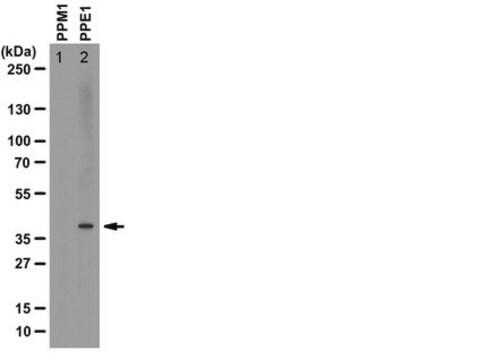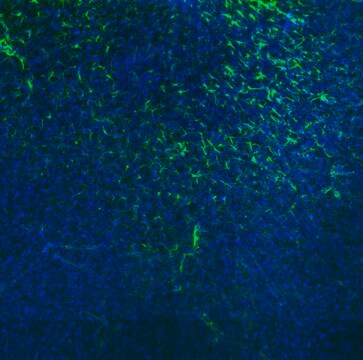MABE1809
Anti-methyl PP2Ac (L309) Antibody, clone 7C10-C5
Synonym(e):
Serine/threonine-protein phosphatase 2A catalytic subunit alpha isoform
About This Item
Empfohlene Produkte
Biologische Quelle
mouse
Qualitätsniveau
Antikörperform
purified antibody
Antikörper-Produkttyp
primary antibodies
Klon
7C10-C5 (short 7C10), monoclonal
Mol-Gew.
calculated mol wt 35.59 kDa
observed mol wt ~35 kDa
Speziesreaktivität
yeast, human
Verpackung
antibody small pack of 100 μL
Methode(n)
immunohistochemistry (formalin-fixed, paraffin-embedded sections): suitable
western blot: suitable
Isotyp
IgG1κ
Epitopsequenz
C-terminal
Protein-ID-Hinterlegungsnummer
UniProt-Hinterlegungsnummer
Lagertemp.
-10 to -25°C
Angaben zum Gen
human ... PPP2CA(5515)
Allgemeine Beschreibung
Spezifität
Immunogen
Anwendung
Isotype testing: Identity Confirmation by Isotyping Test.
Isotyping Analysis: The identity of this monoclonal antibody is confirmed by isotyping test to be mouse IgG1 .
Tested applications
Immunohistochemistry Applications: A representative lot detected methyl PP2Ac (L309) in Immunohistochemistry applications (Leonard, D., et al. (2020). Cell. 181(3); 688-701).
Western Blotting Analysis: A representative lot detected methyl PP2Ac (L309) in Western Blotting applications (Frohner, I.E., et al. (2020). Sci Signal. 13(616); eaax6490).
Note: Actual optimal working dilutions must be determined by end user as specimens, and experimental conditions may vary with the end user.
Physikalische Form
Lagerung und Haltbarkeit
Sonstige Hinweise
Haftungsausschluss
Sie haben nicht das passende Produkt gefunden?
Probieren Sie unser Produkt-Auswahlhilfe. aus.
Signalwort
Warning
H-Sätze
Gefahreneinstufungen
Eye Irrit. 2 - Skin Sens. 1
Lagerklassenschlüssel
11 - Combustible Solids
WGK
WGK 2
Analysenzertifikate (COA)
Suchen Sie nach Analysenzertifikate (COA), indem Sie die Lot-/Chargennummer des Produkts eingeben. Lot- und Chargennummern sind auf dem Produktetikett hinter den Wörtern ‘Lot’ oder ‘Batch’ (Lot oder Charge) zu finden.
Besitzen Sie dieses Produkt bereits?
In der Dokumentenbibliothek finden Sie die Dokumentation zu den Produkten, die Sie kürzlich erworben haben.
Unser Team von Wissenschaftlern verfügt über Erfahrung in allen Forschungsbereichen einschließlich Life Science, Materialwissenschaften, chemischer Synthese, Chromatographie, Analytik und vielen mehr..
Setzen Sie sich mit dem technischen Dienst in Verbindung.









